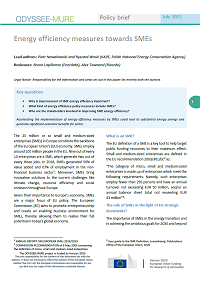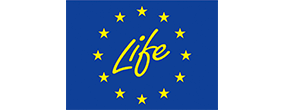Summary
Key questions
- Why is improvement of SME energy efficiency important?
- What kind of energy efficiency policy measures include SMEs?
- Who are the stakeholders involved in improving SME energy efficiency?
Accelerating the implementation of energy efficiency measures by SMEs could lead to substantial energy savings and generate significant economic benefits for sector.
Lead authors: Piotr Nowakowski and Ryszard Wnuk (KAPE, Polish National Energy Conservation Agency)
Reviewers: Bruno Lapillonne (Enerdata), Alex Townend (Ricardo)
The 25 million or so small and medium-sized enterprises (SMEs) in Europe constitute the backbone of the European Union’s (EU) economy. SMEs employ around 100 million people in the EU. Nine out of every 10 enterprises are a SME, which generate two out of every three jobs. In 2018, SMEs generated 56% of value added and 67% of employment in the non-financial business sector1. Moreover, SMEs bring innovative solutions to the current challenges like climate change, resource efficiency and social cohesion throughout Europe.
Given their importance to Europe’s economy, SMEs are a major focus of EU policy. The European Commission (EC) aims to promote entrepreneurship and create an enabling business environment for SMEs, thereby allowing them to realise their full potential in today’s global economy.
What is an SME?
The EU definition of a SME is a key tool to help target public funding resources to their maximum effect. Small and medium-sized enterprises are defined in the EU recommendation 2003/361/EC2 as:
“The category of micro, small and medium-sized enterprises is made up of enterprises which meet the following requirements. Namely, such enterprises employ fewer than 250 persons and have an annual turnover not exceeding EUR 50 million, and/or an annual balance sheet total not exceeding EUR 43 million”3.
The role of SMEs in the light of EU strategic documents?
The importance of SMEs in the energy transition and in achieving the ambitious goals for 2030 and beyond has been expressed at a European level in many strategic documents elaborated by the EC.
The EC recognises a significant role for the SME sector in the proposed action plan of the ‘European Green Deal’4 (2019), and provides for dedicated support measures for SMEs to fulfil this role. Further to this, the European Innovation Council is targeting support in the form of funding, equity investment and business acceleration services at start-ups and SMEs with significant innovation potential, so that innovative solutions can be rapidly scaled up for the global market. Furthermore, the Green Deal emphasises the importance of building refurbishment for reducing energy poverty through lower energy bills and improved living conditions. Building refurbishment can also boost the construction sector and is an opportunity to support SMEs and local jobs.
In March 2020, the EC announced a ‘SME Strategy for a sustainable and digital Europe’5, which aims to support SMEs not just to grow, but also to become more competitive, resilient, and sustainable. The SME strategy sets out an ambitious, comprehensive and cross-cutting approach, based on horizontal measures to help all kinds of SMEs.
The EU’s existing SME policy framework and support programmes, particularly the 2008 Small Business Act, the 2016 ‘Start-up and Scale-up Initiative’, the ‘Competitiveness of Enterprises and Small and Medium-sized Enterprises’ (COSME) Programme, and SME support actions funded under the Horizon 2020 programme and the European Structural Investment Funds, create the well-grounded environment for the implementation of the SME strategy. It will play an instrumental role in realisation of, inter alia, the European Green Deal, the ‘Circular Economy Action Plan’, the ‘European data strategy’, and the ‘European Pillar of Social Rights’.
The SME strategy establishes actions based on the following three pillars:
- Capacity-building and support for the transition to sustainability and digitalisation
- Reducing regulatory burden and improving market access
- Improving access to financing
With regards to the above-mentioned pillars, there are many provisions in the strategy highlighting the path towards a climate neutral, resource efficient and agile digital economy. The ‘Enterprise Europe Network’ (EEN) is already helping SMEs to become more sustainable. The SME strategy provides for dedicated Sustainability Advisors through the EEN, to provide advice on investment in more resource-efficient and circular processes and infrastructure. Moreover, SMEs will continue to be helped by the ‘European Resource Efficiency Knowledge Centre’ (EREK) on ways to save on energy, material and water costs. SMEs could also benefit from solutions offered by energy service companies (ESCOs) that have both know-and technical and financing expertise.
In conclusion, increasing SMEs’ energy efficiency is in line with the direction and provisions of the SME strategy and will undoubtedly play a key role in creating a climate neutral and innovative economy.
Overview of energy efficiency measures for industry
The aim of this policy brief is to provide an insight into energy efficiency policy measures implemented for SMEs in the industrial sector. The main source for the analysis is the MURE database, which maintains a current record of energy efficiency policy measures implemented across all EU countries plus Norway, Serbia, Switzerland and the United Kingdom.
The analysis focused on measures targeted at industry SMEs, or for which industry SMEs are eligible. As of May 2021, the MURE database contained a total of 206 ongoing energy efficiency measures, of which 23 are dedicated measures and a further 104 include industry SMEs within their scope.
The total number of measures varies country by country from one to twelve (for Germany and Latvia respectively). The average number of measures is four and the median is three, which shows that the importance of improved SME energy efficiency has not been ignored by current policies.
Support for industry SMEs to improve their energy efficiency is provided through a wide range of measures, as is presented in Figure 1 opposite. Financial measures are a core part of the policy mix and is the type of support provided by most countries. Financial measures are often combined with a wide range of information, education and training measures, that can include information campaigns, energy audits and workforce training in energy efficiency. The role of information measures has grown – as many as 19 out of 29 countries have introduced this type of measure. In contrast market-based instruments are not well developed and only Sweden has introduced this type of measure (in 1992) on technology procurement. Legislative measures in the form of mandatory standards/information are as equally popular as co-operative measures, which in the main have been implemented as voluntary agreements; such voluntary agreements are a relatively new type of measure that has mostly been introduced since 2010.
Figure 1: On-going measures by Type and by Country
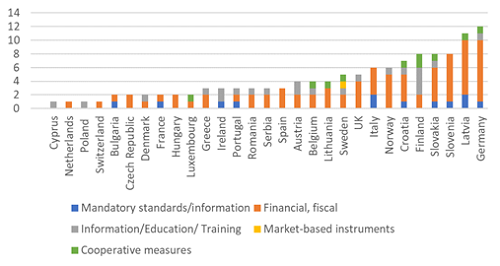
Source: MURE database
Based on the breakdown of on-going measures identified in Figure 1 above, it can be said that financial or fiscal measures are the most popular type of measure, accounting for 63% of all measures that are currently being implemented. In second place are information, education and training measures (19%), followed by mandatory standards/information measures (10%) and co-operative measures (8%).
Figure 2: Types of on-going measures
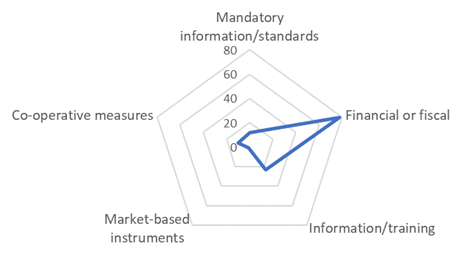
Source: MURE database
Financial or fiscal measures, which are a key part of the policy mix, provide subsidy-based incentives to industry SMEs. Support is targeted at the two types of activity shown in Figure 3, with support for investments in efficient and renewable technologies provided in conjunction with energy audits and training activities for energy managers. Energy audits and training can act as a trigger for unlocking investment potential within industry SMEs, through the identifying areas of wastage and help with specifying energy efficient solutions to these.
Figure 3: Division of subsidy-based measures
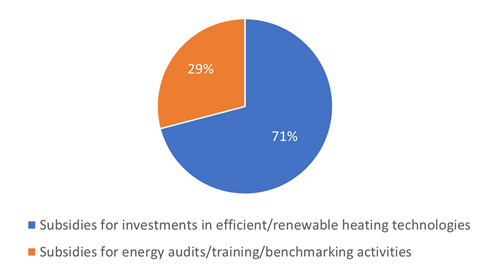
Source: MURE database
Alongside the quantification and geographical spread of energy efficiency measures, the stakeholders or actors involved, and impact of the measures are also of high importance.
Figure 4: Engagement of different types of actors in on-going measures
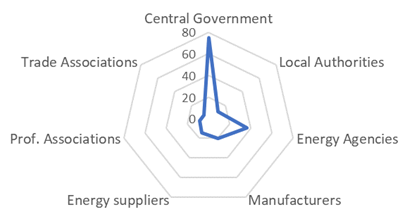
Source: MURE database
The successful implementation of energy efficiency policy measures requires the involvement of different actors. Countries usually make their central government bodies responsible for the development and implementation of policies and measures. Those government bodies are frequently supported by non-governmental energy agencies, which have capacity and expertise in this field. Scandinavian countries such as Finland, Sweden, and Norway are a good example of how central government can co-operate with national agencies to successfully implement energy efficiency programmes; in fact in Norway, implementation is entirely in hands of the Norwegian Energy Agency. Manufacturers are also important. Other actors involved in the implementation of such programmes include energy suppliers, local authorities and professional associations.
The engagement of different stakeholders in EU countries is presented in Figure 5 below.
Figure 5: Engagement of different types of actors in EU countries. (In one measure more than one actor can be engaged)
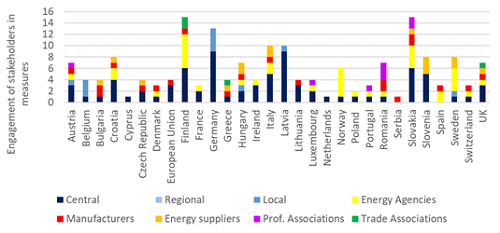
Source: MURE database
The impact of the measures is also of high importance. Generally, there is a strong linkage between impact and type of measure. In most cases those measures identified as high impact are financial measures (usually subsidies or loans), that are for investments to improve energy efficiency. The measures characterised as low impact measures are mostly information and training activities. Most of the measures in the database have a low impact, as is illustrated by Figure 6 below. Measures with a high and medium impact are equally popular.
Figure 6: Impact of on-going measures
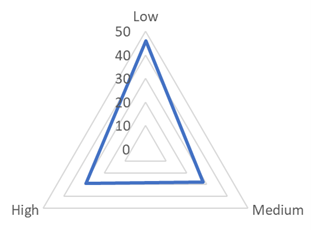
Source: MURE database
Conclusions
Small and medium-sized companies are significant contributors to energy consumption thus they need to be encouraged to improve energy efficiency. SMEs are a very heterogeneous group of enterprises to be targeted with uniform incentives. However, the most important barriers to implementing energy efficiency measures generally consist of a lack of motivation to undertake such actions, a lack of information and knowledge, a shortage of personnel, complexity of support, the need for capital expenditure, and a limited understanding of policy instruments.
The MURE database includes some measures specifically targeted at SMEs and others that have a wider scope but still affect SMEs. Some policy instruments are sector specific or exclude certain sectors. Described policy instruments are also grouped into categories: Financial Support; Information and Advice; and Regulation.
Financial support measures include investment fund initiatives, loans, grants and tax relief. Most common sources of financial support are national governments and the EU; for example, the ‘Financial incentives for investment in energy efficiency and renewable energy sources in SMEs’ in Slovenia. However, investment support in some countries is primarily targeted at larger companies as they have a higher energy consumption.
Regulation measures may include efficiency obligation schemes, EPCs and minimum energy standards; for example the Polish ‘White certificates scheme’, which applies to all sectors of the economy but is targeted especially at industry.
Information and advice measures comprise of tools, awareness rising and capacity building. An example is the ‘Centre for energy savings in enterprises’ in Denmark. However, even if information and support is readily available and accessible on agencies or governmental websites, SMEs seldom actively look for the information of their own accord.
Current policy instruments include many elements that could help and encourage SMEs, but more emphasis on sharing information and best practices dissemination seems to be crucial for wider adoption.
Accelerating the implementation of energy efficiency measures by SMEs could lead to substantial energy savings. It could also generate significant economic benefits by improving SMEs’ productivity, competitiveness and resilience, as well as wider social and environmental benefits. However, it is apparent that that the large potential for energy efficiency in the sector will not be realised without support programmes that target SMEs. The experiences from ongoing or already completed measures should show how governments, industry associations, financial institutions and other stakeholders can develop and implement effective programmes. The lessons learned from completed measures should be utilised in the creation and execution of new energy efficiency programmes.
Notes
- 1: ANNUAL REPORT ON EUROPEAN SMEs 2018/2019
- 2: COMMISSION RECOMMENDATION of 6 May 2003 concerning the definition of micro, small and medium-sized enterprises
- 3: User guide to the SME Definition, Luxembourg: Publications Office of the European Union, 2020
- 4: COMMUNICATION FROM THE COMMISSION TO THE EUROPEAN PARLIAMENT, THE EUROPEAN COUNCIL, THE COUNCIL, THE EUROPEAN ECONOMIC AND SOCIAL COMMITTEE AND THE COMMITTEE OF THE REGIONS: The European Green Deal, European Commission, Brussels, 2019
- 5: An SME Strategy for a sustainable and digital Europe, European Commission, Brussels, 2020
